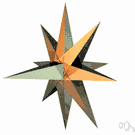asteroid
Also found in: Thesaurus, Medical, Acronyms, Encyclopedia, Wikipedia.
as·ter·oid
(ăs′tə-roid′)n.
1. Astronomy Any of numerous small solar system bodies that revolve around the sun, with orbits lying chiefly between Mars and Jupiter and characteristic diameters roughly between one and several hundred kilometers. Also called minor planet, planetoid.
2. Zoology See starfish.
adj. also as·ter·oi·dal (ăs′tə-roid′l)
Star-shaped.
American Heritage® Dictionary of the English Language, Fifth Edition. Copyright © 2016 by Houghton Mifflin Harcourt Publishing Company. Published by Houghton Mifflin Harcourt Publishing Company. All rights reserved.
asteroid
(ˈæstəˌrɔɪd)n
1. (Celestial Objects) Also called: minor planet or planetoid any of numerous small celestial bodies that move around the sun mainly between the orbits of Mars and Jupiter. Their diameters range from 930 kilometres (Ceres) to less than one kilometre
2. (Zoology) Also called: asteroidean any echinoderm of the class Asteroidea; a starfish
adj
3. (Zoology) of, relating to, or belonging to the class Asteroidea
4. shaped like a star
[C19: from Greek asteroeidēs starlike, from astēr a star]
Collins English Dictionary – Complete and Unabridged, 12th Edition 2014 © HarperCollins Publishers 1991, 1994, 1998, 2000, 2003, 2006, 2007, 2009, 2011, 2014
as•ter•oid
(ˈæs təˌrɔɪd)n.
1. any of the thousands of small, solid bodies that revolve about the sun in orbits largely between Mars and Jupiter.
adj. 2. starlike.
as`ter•oi′dal, adj.
Random House Kernerman Webster's College Dictionary, © 2010 K Dictionaries Ltd. Copyright 2005, 1997, 1991 by Random House, Inc. All rights reserved.
as·ter·oid
(ăs′tə-roid′) Any of numerous small, often irregularly shaped bodies that orbit the sun. Asteroids range from several hundred miles in diameter to the size of a speck of dust. ♦ Most are found in the region between the orbits of Mars and Jupiter known as the asteroid belt. See Note at solar system.
The American Heritage® Student Science Dictionary, Second Edition. Copyright © 2014 by Houghton Mifflin Harcourt Publishing Company. Published by Houghton Mifflin Harcourt Publishing Company. All rights reserved.
ThesaurusAntonymsRelated WordsSynonymsLegend:
Switch to new thesaurus
| Noun | 1. | asteroid - any of numerous small celestial bodies composed of rock and metal that move around the sun (mainly between the orbits of Mars and Jupiter) Chiron - an asteroid discovered in 1977; it is unique in having an orbit lying mainly between the orbits of Saturn and Uranus minor planet, planetoid - any of numerous small celestial bodies that move around the sun |
| Adj. | 1. |  asteroid - shaped like a star asteroid - shaped like a star |
Based on WordNet 3.0, Farlex clipart collection. © 2003-2012 Princeton University, Farlex Inc.
asteroid
noun planetoid, minor planet It's only a matter of time before a giant asteroid destroys the Earth.
Asteroids
Ceres, Eros, Hermes, Hesperia, Juno, Pallas, PhaethonCollins Thesaurus of the English Language – Complete and Unabridged 2nd Edition. 2002 © HarperCollins Publishers 1995, 2002
Translations
asteroidi
Collins Spanish Dictionary - Complete and Unabridged 8th Edition 2005 © William Collins Sons & Co. Ltd. 1971, 1988 © HarperCollins Publishers 1992, 1993, 1996, 1997, 2000, 2003, 2005
Collins English/French Electronic Resource. © HarperCollins Publishers 2005
asteroid
n → Asteroid m
Collins German Dictionary – Complete and Unabridged 7th Edition 2005. © William Collins Sons & Co. Ltd. 1980 © HarperCollins Publishers 1991, 1997, 1999, 2004, 2005, 2007
Collins Italian Dictionary 1st Edition © HarperCollins Publishers 1995